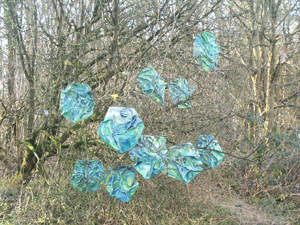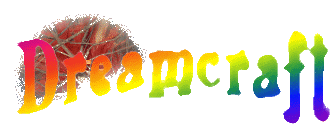

Spring Foliage
Spring Equinox 2002
Note how the composition and lighting of the piece varies with viewing angle, like a sculpture, although composed entirely of 2-D elements.
|
Easter
Although it is easy to see the pagan roots of Easter in the symbolism of rabbits and eggs, and in the way the festival is dated by lunar events (The First Sunday after the First Full Moon after the Spring Equinox), this is one of the festivals least influenced by Northern European pagan traditions.
There is no historical or archaeological evidence for a Northern European precursor to Easter: The Celts and Romans used a solar calendar, and had no moveable feasts. The Celtic Spring festival was on May Day, and the Teutonic festivals of renewal were closer to our New Year.
Followers of Wicca claim that the Saxons celebrated a Spring Equinox festival called “Ostara”, sacred to a goddess Eostre. However, this is a fanciful embroidery of history based on the fact that the Saxon name for April was “Eostermonath”, meaning “Month of awakening”, from which the words ‘Easter’ and ‘East’ are apparently derived. Neither the festival nor the goddess is mentioned in any historical writing.
Easter was a second century addition to the Christian calendar, and was adopted from the Judaic festival of Passover, which is the time at which Christ was actually supposed to have died.
In turn, Passover is one of the most ancient of Judaic festivals, celebrating the escape of the Jewish people from Egyptian slavery (The Exodus). Whether or not the Exodus is historical (a matter of fierce debate), it appears that this date was already celebrated by the Jewish people, and already involved the slaughter of a lamb, and that it’s true origins lie far back in prehistory ... possibly an ancient middle-eastern Spring festival of renewal, adapted for the celebration of the Exodus at a later date.
|






